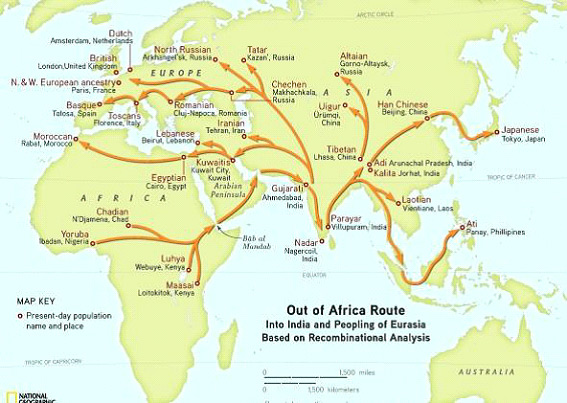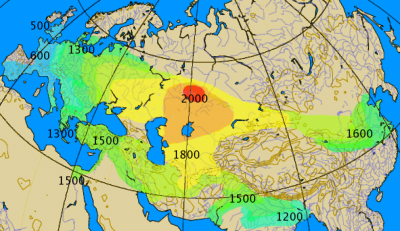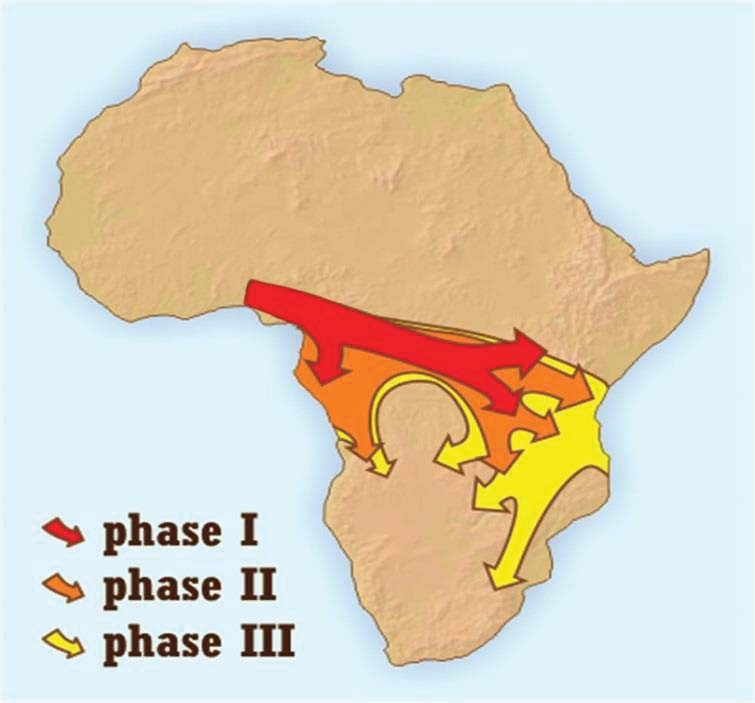
It must be noted that ethnic labels are latter day social constructs, and in reality, Niger Kongo ethnolinguistic groups are a continuum of dialects.
Just as the Niger Kongo ethnolinguistic group should have been named Niger-Limpopo to reflect the full geographic extent, the Volta Niger which is the focus of this article is a subgroup that would have been more aptly named as Volta-Benue to accommodate Idomas and eastern Ndigboland.
Genetics has made us realize the first ethnic differentiation occurred between Yorubas and San pygmies around 87,000 yrs ago, according to DNA evidence analysed by Harvard Medical School Simmons Genome Diversity Project released in 2017.
Other comparative studies of the global genetics databases held by the Human Genome Project USA and Foundation Jean Dausset-CEPH in Parisi have revealed that Yoruba DNA to be the oldest in studies by Sarah Tishkoff and Etienne Patin.
We also have genetic studies to show that the next line of pygmies, Mbuti, and other full stature Black Africans began to differentiate from about 50,000yrs ago. In a global DNA comparative analysis, it is obvious that the DNA figures of the Niger Kongo ethnolinguistic groups fall as you move away from Yorubaland.
It has been long argued that due to the physiological makeup of Man, he must have evolved close to the coast, preferably in mangrove and freshwater swamps.
In a study conducted by Kyoto University’s Yusouka in 2013, the Wild Yam Question was answered and the long standing dispute was put to rest that the first source of food was wild yams.
From these and other evidences one can conclude that the most likely forest of evolution is the bell shaped rainforest between Ijebuland to the West, Benin to the East and Ife to the north, which is now officially called Ife Forest Reserves but traditionally known as the Igbo Irunmole – Forests of Ancestral Spirits.
The local knowledge bank, dismissed until recently as mythology, tells us that in the beginning Man as an Irunmole, Spiritual being, started from the Ife forests reserves. Oduduwa, the progenitor of Yorubas, Obatala, Olu Iwa and many others are linked to this forest. According to Yoruba oral history Oduduwa was the first to humanize his spiritual existence followed by others. We are told how in the evolutionary process all except Ijimere successfully evolved.
Local knowledge tells us that the exact site of Ile Ife moved, probably due to climatic epochs leading to flooding or aridity until it’s final and present location. It was from here that we blossom into communities and laid the foundations of human civilization. The first markets were established by Obatala descendants linked to Igbos. The lunar calendar was started. Our knowledge bank was organized into the 16 sector of Ifa, the Original African information retrieval system, which inspired mathematics, physics, medicine, quantum physics, metallurgy and various studies.
Full stature Black Africans began to migrate out and from genetic and cultural anthropological studies, Yorubas became Igala, who diverged into Idoma and Igbos. As stated above tribal labels were later classifications and the genetics gives us the direction of migration of a single people.
To the Southwest, descendants of Oduduwa migrated to Ketu and onto Tado in Benin Republic. It was from Tado, the brothers were to create the Aja, Fon and Ewe that spread through Southern forests of Benin Republic into Togo and Ghana. Ewes refer to Ketu as Amedzofe (“origin of humanity”) or Mawufe (“home of the Supreme Being”).

While the migration through the rainforest was more of trickles, a larger number of migrants went up the River Niger and settled in its savannas until they reached the Senegambian Atlantic Coast.
It is believed that Oduduwa and many other Orishas/Irunmole are more of essences that keep repeating overtime in different eras of global collective consciousness. This translates to the fact that Oduduwa at the point of human evolution wasn’t the same as Oduduwa that brought the monarchical system in 1000AD!
From linguistic and genetic evidence, the Volta-Benue language family, appear to be the oldest and core of the Niger-Kongo ethnolinguistic groups. Rather than been separate families categorized only because of linguistic similarities, it is argued that the Niger-Kongo ethnolinguistic family is a continuum of dialects from the single mother tongue, which could be best described as archaic Yoruba.
This argument is supported by the change in DNA values along migratory routes. It is also supported with grottochronology studies that calculate the rate of linguistic divergences over time and distance. It is accepted that there have been different waves of migrations due to ecological and sociopolitical events.
Initially, the Volta-Benue ethnolinguistic groups were extended to cover the whole of the Yam belt that extends from Cross River in Nigeria to Bandama River in Ivory Coast, closer scrutiny showed a difference in language and social organization tied to later migrations trends.
The Kwa in East Ghana/Ivory Coast and the Benue – Congo that includes Plateau and Bantu ethnolinguistic families from Nigeria to South Africa were separated from Volta Niger family due to belonging to later migratory trends, not directly from Ife but Ife emigrants that make up the Volta-Niger ethnolinguistic source group.
One key characteristic of the Volta Niger ethnolinguistic group is that the presence of the 16 divisions of Original African Information retrieval system aka Ifa/Afa/Iha, that held their ancient history, culture and science.

This settlements were mainly led by spiritual leaders, philosopher kings long before the creation of monarchical dynasties of the last few thousand years.
From global migratory evidence, we can deduct that indigenous peoples carried along Ifa, the first structured knowledge bank and social organization led by its spiritual/philosopher kings.
Evidence of this can be deducted from the Ogisos in Benin and Eze across Ndigboland to faraway lands like Ethiopia where the first king was called Ori and the system was based on Erecha.
In the 96 dug up cities of the Indus Valley civilization, which DNA proves were Black Indigenous civilizations, the sociopolitical organization points to spiritual/philosophy kings without glamour. The Eurasian invaders that destroyed it copied the Original African knowledge bank into what is known as the Rig Veda that became the template of Buddhism.
These all goes to prove that the first social organization was based on Ifa until another wave of migratory trends changed the global consciousness.
The celebration of the monarchical Crown known as Olojo festival in Ife ties it to Ogun, the Iron Age believed to have started around 2000BC.
Although it is believed that the Yorubas and it’s larger Volta-Niger cultural sphere first started the Iron Age (Lejja 1900BC), we didn’t weaponize Iron and only used it for productive functions. Unlike, those in arid environments that set out to conquer with brute force devised from bows and arrows and horse chariots.
The Iron Age inspired another wave of migration patterns due to the fact that improved farming with iron tools would require more arable land, as well as the imperialistic pressures from the arid lands to the North. This period brought about the fall of the ancient Black African frontier empire, Egypt to Eurasians (Jews) and Afroasians (Arabs) whose ripple effects were felt across Africa.

The Age of Ogun, Iron Age was followed by the current Age of Olokun, political and religious dogma which conceptualized the Ogun reign of brute force into monarchical imperialistic systems of today.
The Volta Niger ethnolinguistic groups diverged into new groups with the new migratory trends and routes.
To the East, the group birthed the Benue-Congo ethnolinguistic group that included Central Nigerian Plateau groups of the Jukun and Ham that later formed the Kwararafa and Nok empires, as well as the Bantu groups that spread into Cameroon and went down the Sangha and Chari River until they reached the Ugbangi River, where they once again differentiated into Western (Kongo) and Eastern (Marshariki) Bantus. The Eastern Bantus, the Marshariki Bantus diverged into East and South Africans.
To the east of the Volta-Niger originating group, there were those that had spread through the rainforests Yam belt at a slow rate and those who migrated along the Niger and Savannas.

The former group, the forest dwellers collectively known as Gbe had their population increased by another wave of migrants from Oyo Empire, attracted by gold trade who were called Eyo, miners.
The Gbe were to build an important empire called Tado. The fall of Tado tied to the advent of Europeans lead to other the springing up of other kingdoms like Allada and Ahomey. The culture remained relatively unchanged and kept the characteristics of the Volta-Niger group.
Those in the grasslands between River Niger and Upper Volta formed spiritual empires like Ghana until the advent of Afroasians.
The upheaval in the grasslands led to the migration of the Kwa group down River Pra where they diverged into Akan, Fante, Baoule and other Twi speakers.
Initially staying in Kumasi, the Akan group mingled with the Volta Benue groups but the militarization of the area by Europeans led to the creation of empires like Denkyira and Akwamu by military commanders, who depart from the Volta Benue traditions of separating the role of the King (Oba) from that of the commander in Chief of Armed Forces (Balogun).
The Kwa group spread to takeover the virgin coastal rainforests up to the eastern banks of Volta River. Their sociopolitical organization drew from the Volta-Benue groups especially over the last 500yrs. This closeness is why the Kwa ethnolinguistic group was formerly counted as part of Volta-Benue ethnolinguistic group.
The previous Benue-Congo migrants that remained in Savanna grasslands, the Atlantic Senegambian and Kordofian Sudanese had their linguistics and other cultural and sociopolitical templates affected by the Afro-Asians marauders, taking questions over their indigenous.
Original African credentials.
At the core of the Volta-Niger ethnolinguistic group, Yoruba and Ndigboland, monarchical dynasties were introduced that affected the social makeup. The descendants of Oduduwa in the current Olokun era was attributed the feat of establishing dynasties in Oyo, Benin and Onitsha. Across Yorubaland, especially in Yoruba cities states, it is not uncommon to have different kings and towns like Modakeke and Ondo attributed to Oyo as opposed to Ife.
In Ndigboland, the monarchical system was largely resisted and restricted to places like Onitsha. The Eze system still existed however due to its language divergence from Yoruba, the language of its Afa information retrieval system, it could no longer serve as a unifying tool.
The advent of European colonization and categorization of the Volta-Niger ethnolinguistic group into ill defined tribes has further confused the family
.
The translation of Volta-Niger languages by different scholars from different Indo-European backgrounds – British Nigeria, French Benin and Germany Togo – has done a disservice to our languages. For example guttural tonal sounds have left out of many languages making them lose their Bantu connections like Kpele now written as Pele.
The Abrahamic cultural spheres that most Volta Benue people’s have adopted them have robbed them of the awareness that they share the same Original African information retrieval system, the same moral values based on natural laws of Retributive Justice, and that they have common cultural and genetic origins and collective aspirations from Benue to Volta.








